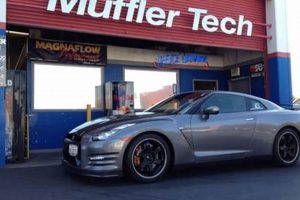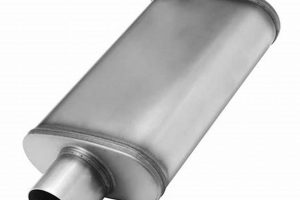A specific type of exhaust component offers a design facilitating unrestricted passage of exhaust gases. Unlike baffled designs, this component allows for a direct, minimally obstructed pathway. This configuration minimizes backpressure, potentially enhancing engine performance. For example, a vehicle experiencing restricted exhaust flow due to a conventional muffler might benefit from replacement with this type of component, potentially leading to increased horsepower and improved fuel efficiency.
The reduced backpressure achieved through this design can offer several advantages. Historically, modifications aiming at increasing exhaust flow have been a common method for boosting engine output. Lower backpressure can result in improved scavenging of exhaust gases from the cylinders, leading to a more complete combustion cycle. This improvement may also translate to a more aggressive exhaust note, a characteristic often sought after by performance enthusiasts.
The following discussion will delve into the construction and materials used, explore the measurable impact on vehicle performance, and examine the considerations for selecting the appropriate component for a given application.
Optimizing Performance with an Unrestricted Exhaust System
The following guidance focuses on selecting and implementing a specific type of exhaust component, designed to minimize backpressure and maximize exhaust flow, for optimal vehicle performance.
Tip 1: Material Selection: Employ stainless steel variants for enhanced corrosion resistance, particularly in regions with harsh winter conditions or coastal climates. This material offers longevity and structural integrity.
Tip 2: Diameter Matching: Ensure the component’s inlet and outlet diameters align with the existing exhaust system. A mismatch can negate the benefits of reduced backpressure and create flow disruptions.
Tip 3: Professional Installation: Engage a qualified technician for installation. Incorrect welding or mounting can lead to leaks, vibrations, and potential damage to the exhaust system or vehicle chassis.
Tip 4: Noise Considerations: Understand that reduced backpressure often results in a louder exhaust note. Research different designs and sound-deadening materials to manage noise levels to an acceptable range.
Tip 5: Engine Tuning: When installing this type of performance exhaust component, consider retuning the engine’s ECU to optimize air-fuel ratios and ignition timing. This maximizes the performance gains from the improved exhaust flow.
Tip 6: Regulatory Compliance: Verify local regulations regarding exhaust modifications. Ensure the selected component meets noise and emissions standards to avoid legal complications.
Tip 7: Periodic Inspection: Regularly inspect the component for signs of wear, corrosion, or damage. Addressing issues promptly can prevent more significant problems and maintain optimal performance.
Adherence to these guidelines can help ensure that the implementation of an unrestricted exhaust design results in the desired performance enhancements while maintaining vehicle reliability and regulatory compliance.
The subsequent sections will address common troubleshooting scenarios and provide insights into long-term maintenance strategies.
1. Unrestricted Exhaust Path
The unrestricted exhaust path is a defining characteristic and integral component of a “total flow muffler.” This design philosophy centers on minimizing obstructions within the muffler, allowing exhaust gases to flow through with minimal resistance. The direct consequence of this design is a reduction in backpressure, which can significantly impact engine performance. A “total flow muffler,” by prioritizing an unrestricted path, actively promotes efficient exhaust gas scavenging from the engine cylinders.
For example, consider two vehicles, both equipped with the same engine. One utilizes a conventional baffled muffler, while the other incorporates a “total flow muffler.” The vehicle with the conventional muffler experiences increased backpressure, hindering the engine’s ability to expel exhaust gases completely. This residual exhaust gas contaminates the subsequent intake charge, reducing combustion efficiency. Conversely, the vehicle with the “total flow muffler” benefits from the reduced backpressure, resulting in more complete combustion and potentially higher horsepower output. The practical significance of understanding this connection lies in the ability to select exhaust components that optimize engine performance based on specific vehicle needs and desired outcomes.
In summary, the unrestricted exhaust path is not merely a feature of the “total flow muffler”; it is the core principle driving its functionality and performance benefits. It allows for efficient exhaust scavenging, minimizes backpressure, and contributes to increased engine power. While the specific advantages can vary depending on the engine and vehicle application, the underlying principle remains constant: the unrestricted exhaust path is fundamental to the “total flow muffler” design and its capacity to enhance performance.
2. Minimized Backpressure
Reduced backpressure is a primary objective in exhaust system design, particularly when considering the application of a “total flow muffler.” Backpressure, the resistance to exhaust gas flow, negatively impacts engine efficiency and performance. The design of a “total flow muffler” directly addresses this issue by facilitating a more direct and less restrictive path for exhaust gases.
- Engine Efficiency
Excessive backpressure hinders the engine’s ability to expel exhaust gases completely, resulting in residual exhaust gas remaining in the combustion chamber. This contamination reduces the volume of fresh air and fuel that can enter the cylinder, leading to incomplete combustion and decreased power output. The “total flow muffler,” by minimizing backpressure, promotes more efficient cylinder scavenging, improving the air-fuel mixture and combustion process.
- Power Output
The reduction in backpressure directly translates to improved engine horsepower and torque. When an engine can more easily expel exhaust gases, it operates more efficiently, generating more power. Dyno tests often reveal an increase in horsepower when a “total flow muffler” replaces a more restrictive design. This performance gain is particularly noticeable at higher engine speeds, where exhaust gas flow is at its maximum.
- Fuel Economy
While primarily intended for performance enhancement, a “total flow muffler” can also contribute to improved fuel economy in certain situations. When the engine operates more efficiently due to reduced backpressure, it requires less fuel to produce the same amount of power. However, the primary driver for fuel economy remains driving style and engine tuning, with the “total flow muffler” playing a supporting role.
- Thermal Management
Backpressure can contribute to increased exhaust gas temperatures. Restricting exhaust flow causes gases to linger in the exhaust manifold and catalytic converter, potentially leading to overheating. By minimizing backpressure, a “total flow muffler” can improve thermal management within the exhaust system, reducing the risk of component failure.
The interconnected nature of these facets demonstrates the critical role minimized backpressure plays in the overall performance and longevity of an engine. The “total flow muffler,” designed specifically to achieve this objective, offers a viable solution for optimizing engine performance and efficiency. Further, proper installation and maintenance are essential to realizing the full benefits of the reduced backpressure design.
3. Performance Enhancement
The modification of an exhaust system with components designed to maximize flow has become a prevalent method for enhancing vehicle performance. One specific element within this context is the “total flow muffler,” a design characterized by its minimal restriction to exhaust gas passage. This component’s role in facilitating performance gains warrants thorough examination.
- Increased Horsepower and Torque
The primary pathway through which a “total flow muffler” enhances performance is the reduction of backpressure. Excessive backpressure inhibits the engine’s ability to efficiently expel exhaust gases, leading to a decrease in horsepower and torque. By minimizing flow restriction, this type of muffler allows the engine to operate more freely, yielding improved power output, particularly at higher RPM ranges. For instance, dyno testing frequently reveals a quantifiable increase in peak horsepower and torque figures following the installation of a “total flow muffler.”
- Improved Throttle Response
The responsiveness of an engine to throttle inputs is significantly impacted by exhaust system design. A restrictive exhaust system can create a lag between throttle application and engine reaction. By providing a less obstructed pathway for exhaust gases, a “total flow muffler” reduces this lag, resulting in more immediate and responsive throttle control. This improvement is particularly noticeable during acceleration and deceleration, contributing to a more engaging driving experience.
- Enhanced Engine Breathing
Efficient engine operation depends on the ability to both draw in fresh air and expel exhaust gases effectively. A “total flow muffler” promotes enhanced engine breathing by reducing the resistance to exhaust gas flow. This improved scavenging effect allows for a more complete combustion process, leading to increased power and fuel efficiency. The enhanced breathing translates to a more efficient engine operating cycle, contributing to overall performance gains.
- Potential for Increased Fuel Efficiency
While primarily aimed at performance augmentation, the implementation of a “total flow muffler” can, under specific circumstances, result in improved fuel efficiency. When the engine operates more efficiently due to reduced backpressure and improved scavenging, it requires less fuel to generate a given level of power. However, it is crucial to acknowledge that the realized fuel efficiency gains are highly dependent on driving style, engine tuning, and other vehicle modifications. This benefit is often secondary to the primary goal of performance enhancement.
The benefits of “total flow muffler” can be fully realized through proper installation and tuning. Matching the muffler to the engines exhaust flow requirements and adjusting the engine control unit (ECU) settings can further optimize performance gains. Further research into different performance designs remains critical in achieving any additional enhancement.
4. Sound Characteristics
The sonic signature produced by an exhaust system is a significant aspect influencing vehicle perception and driver experience. The relationship between a “total flow muffler” and the resulting exhaust note is a complex interplay of design, materials, and engine characteristics, requiring careful consideration.
- Volume and Intensity
Due to their design focused on minimizing restrictions, “total flow mufflers” generally produce a louder exhaust note compared to baffled mufflers. The absence of internal baffles allows sound waves to propagate more freely, resulting in increased volume and intensity. Real-world examples include performance vehicles where a louder exhaust is often desirable, signaling enhanced engine power. However, this increased volume necessitates consideration of noise regulations and potential impact on driving comfort.
- Frequency and Tone
The specific frequencies and tones generated by a “total flow muffler” are influenced by factors such as the muffler’s internal dimensions, the type of packing material used (if any), and the engine’s firing order. These factors collectively shape the perceived “sound quality” of the exhaust. Some designs may produce a deep, resonant tone, while others may exhibit a higher-pitched, raspy sound. The selection of materials, such as stainless steel versus aluminized steel, also affects sound propagation characteristics.
- Resonance and Drone
Certain “total flow muffler” designs can exhibit undesirable resonance or drone at specific engine speeds. This phenomenon occurs when exhaust frequencies coincide with resonant frequencies within the vehicle’s body or exhaust system, creating an amplified, often irritating, sound. Careful design considerations, such as the incorporation of resonators or strategically placed sound-deadening materials, are necessary to mitigate drone and maintain acceptable noise levels.
- Subjective Perception
The perceived “quality” of the exhaust note is highly subjective, varying significantly among individuals. Factors such as personal preferences, driving style, and vehicle application all influence the desirability of a particular sound. A “total flow muffler” producing a raw, aggressive exhaust note may be favored by performance enthusiasts, while others may prioritize a quieter, more refined sound. Understanding the intended application and target audience is therefore essential in selecting or designing a “total flow muffler” with appropriate sound characteristics.
In summary, the sound characteristics of a “total flow muffler” are a crucial element impacting the overall driving experience. Balancing the desired performance benefits with acceptable noise levels and tonal qualities necessitates a comprehensive understanding of the underlying acoustic principles and careful consideration of design choices and material selection.
5. Material Durability
Material durability is a paramount consideration in the design and selection of a “total flow muffler.” The exhaust system environment subjects components to extreme conditions, including high temperatures, corrosive gases, road debris, and vibration. The material composition directly dictates the muffler’s lifespan and performance integrity.
- Corrosion Resistance
Exhaust gases contain corrosive compounds such as sulfur dioxide and water vapor, which can rapidly degrade metallic components. The choice of corrosion-resistant materials, such as stainless steel, is crucial for extending the service life of a “total flow muffler.” Stainless steel alloys containing chromium and nickel form a protective oxide layer that inhibits rust formation. In contrast, mild steel mufflers lacking this protective layer are prone to rust and eventual failure, particularly in regions with high humidity or road salt usage.
- Thermal Stability
Exhaust gas temperatures can fluctuate dramatically, reaching several hundred degrees Celsius. Materials used in “total flow muffler” construction must maintain their structural integrity and mechanical properties at these elevated temperatures. Certain grades of stainless steel, such as 304 and 409, exhibit excellent thermal stability, resisting warping, cracking, and oxidation at high temperatures. Conversely, aluminized steel, while offering some corrosion resistance, may be more susceptible to thermal degradation over prolonged exposure to extreme heat.
- Mechanical Strength
The exhaust system is subjected to significant vibration and mechanical stress, particularly during vehicle operation on rough roads. “Total flow muffler” materials must possess sufficient tensile strength and fatigue resistance to withstand these forces. Thicker gauge materials and robust welding techniques are essential for ensuring structural integrity and preventing premature failure due to cracking or weld fatigue. The use of lower-grade materials or inadequate construction methods can result in muffler damage and performance degradation.
- Resistance to Impact Damage
Road debris, such as rocks and salt, can impact the “total flow muffler,” potentially causing dents, punctures, or other forms of physical damage. Materials with high impact resistance, such as thicker gauge stainless steel, provide greater protection against these hazards. The placement of the muffler within the vehicle’s undercarriage also influences its vulnerability to impact damage. Shielding the muffler with protective panels can further enhance its durability.
The choice of materials for a “total flow muffler” represents a trade-off between cost, weight, performance, and durability. While stainless steel offers superior corrosion resistance and thermal stability, it is generally more expensive than aluminized or mild steel. However, the extended lifespan and reduced maintenance requirements of a stainless steel “total flow muffler” may justify the higher initial investment, particularly in demanding operating environments. Thorough assessment of driving conditions and performance priorities is essential for selecting the most appropriate material for a given application.
Frequently Asked Questions
The following section addresses common inquiries and clarifies misconceptions regarding “total flow mufflers,” providing objective information to aid in informed decision-making.
Question 1: Does a “total flow muffler” inherently increase vehicle horsepower?
A “total flow muffler” contributes to horsepower gains by reducing exhaust backpressure. The magnitude of the increase depends on the engine’s characteristics, existing exhaust system restrictions, and other modifications. Gains are not guaranteed and may be minimal in some applications.
Question 2: Are “total flow mufflers” excessively loud?
The sound level of a “total flow muffler” is generally higher than a factory-installed, baffled muffler. The specific volume and tone vary based on design and construction. Some models incorporate sound-absorbing materials or resonators to mitigate excessive noise. Local noise regulations should always be consulted.
Question 3: Can a “total flow muffler” negatively impact fuel economy?
While primarily designed for performance, a poorly selected or installed “total flow muffler” can negatively affect fuel economy. Improper engine tuning or mismatched exhaust system components can lead to inefficient combustion and increased fuel consumption. Optimization is key.
Question 4: What is the expected lifespan of a “total flow muffler?”
The lifespan of a “total flow muffler” is dependent on the materials used, the operating environment, and maintenance practices. Stainless steel mufflers generally exhibit greater longevity than aluminized steel models. Exposure to road salt and other corrosive elements can accelerate degradation.
Question 5: Does the installation of a “total flow muffler” require professional assistance?
Professional installation is recommended for “total flow mufflers.” Improper welding, incorrect alignment, or inadequate support can lead to exhaust leaks, vibrations, and potential damage to the vehicle. Expertise ensures optimal performance and safety.
Question 6: Are “total flow mufflers” legal for street use in all jurisdictions?
The legality of “total flow mufflers” for street use varies significantly by location. Noise emission standards and exhaust modification regulations differ widely. Prior to installation, it is essential to verify compliance with all applicable local, state, and federal laws.
In summary, a “total flow muffler” offers the potential for performance enhancement, but requires careful consideration of factors such as noise levels, fuel economy, legality, and material durability. Informed selection and proper installation are crucial for achieving the desired outcome.
The subsequent section will provide guidance on the selection process, outlining key criteria to consider when choosing a “total flow muffler” for a specific application.
Conclusion
This exploration has examined the “total flow muffler,” a specific type of exhaust component designed to minimize backpressure and enhance engine performance. Key attributes include an unrestricted exhaust path, contributing to increased horsepower, improved throttle response, and potentially enhanced fuel efficiency. Material durability, sound characteristics, and regulatory compliance represent critical considerations in the selection and implementation of this technology.
The appropriate application of a “total flow muffler” necessitates careful evaluation of vehicle specifications, performance objectives, and adherence to legal standards. Responsible implementation, informed by objective data and professional expertise, will determine the success of this modification in achieving the desired performance gains while maintaining vehicle integrity and environmental responsibility. Further research and technological advancements will likely refine the design and application of exhaust system components, continuing the pursuit of optimized engine performance and reduced emissions.







